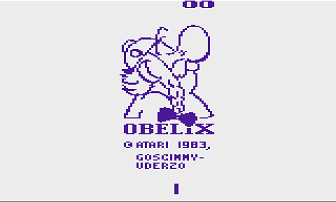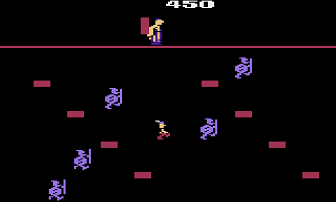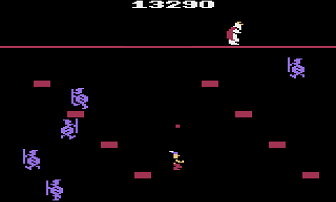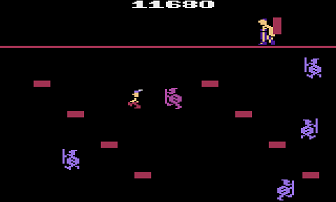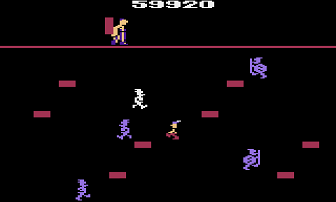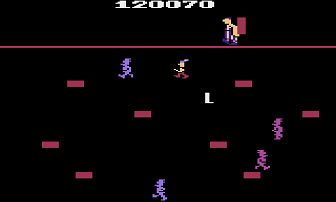OBÉLIX
An Immensely Fun and Highly Original Atari 2600 Obscurity
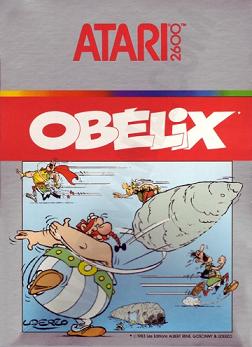
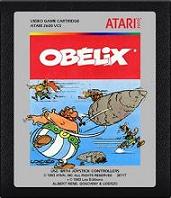
I considered including this article in our "Games That You Should Try Again" series, but it's unlikely that anyone reading this has tried Obélix even once, at least while knowing how to play.
This might have something to do with the fact that it's graphically based on comic-book characters unknown to most Americans. However, as with other video games tied to licenses from external areas of entertainment, such as Superman, Popeye and Taz (to name just a few additional Atari 2600 VCS titles), such imposition is irrelevant. It's the game-play itself that shines or doesn't, and the brightness of Obélix will probably surprise you, if you take the time to get into it.
Just for the record, The Adventures of Asterix, sometimes titled Asterix the Gaul, takes place in an unnamed Gaulish (Ancient French) village full of warriors who battle the Roman Republic. The stories are not, as you've picked up if you're quick, meant to take place in the present.
It's essentially a fictional, lighthearted account of the non-fictional imperialistic bloodshed that occured around 50 B.C. Writer Rene' Goscinny and illustrator Albert Uderzo (who were apparently deft enough to make anything lighthearted) started the series in Brussels, Belgium in 1959. The first stories were serialized in a French comic magazine called Pilote, but devoted "albums" began to appear in '61, thanks to Dargaud, their first publishing company.
The scenario: Asterix and his warrior buddies are lucky enough to know a local druid who enjoys spending his time brewing magical potion. This grants great strength, so they're able to continuously fight off the Ancient Romans who try to take over the village and thus complete their occupation of Gaul.
Sometimes Asterix (translation from the French: Asterisk. Go figure) and company travel to other countries, evidently looking for any poor guy who looks like an Ancient Roman so they can beat the shit out of him.
Obélix serves as the stupid but strong companion to the short but smart Asterix. Both characters appear in this game, teaming up to squash the invaders with massive rocks. Why any kid would want to grow up to be an Ancient Roman, knowing that this stuff would happen to him, is anybody's guess.
The Adventures of Asterix is most familiar to Europeans, South Americans and the English speakers of western Asia. In France and Belgium, it's downright beloved. We're talking cartoon television shows, cartoon movies, real-people movies, toys, snacks, board games, around forty video games and even a theme park near Paris.
And dig this: The very first French satellite, launched into space in '65, was named after the main character. The comic series has been translated into over a hundred languages, and it's still going (although other guys have taken over the writing and drawing, of course).
Funny...I never heard of it until I discovered the two related Atari games in the late '90s.
There's an Asterix cartridge for the 2600 as well, you see, but it's essentially just Taz with different graphics. The game we'll actually be discussing is original from the ground up. The manual doesn't mention every detail and nuance, which is typical. As always, you'll find far more information here. In fact, most of the particulars below haven't been documented anywhere yet.
Because of the foreign draw, most copies of both games conform to the PAL video standard; but a few NTSC cartridges made it out for French Canadians in 1983. The European Obélix doesn't seem to have been issued until the following year.
Suki Lee (Math Gran Prix) did the programming and Dave Jolly designed the graphics. For some reason, it took two guys, Andrew Fuchs and Jeff Gusman, to create the sound effects. They're great, as sounds tend to be on this console, but it's not as if one hears twice as many as in the typical 2600 game.
The action does begin with a brief and very ancient-sounding opening tune, and there's potion music (see below) and death music, so maybe one of the guys handled all of that while the other concocted the actual game sounds.
The titular character tramps to and fro across the top of the playfield, burdered with one giant menhir (roughly hewn rock) after another. The player controls Asterix as he runs around the spacious area below, signaling to his pudgy pal whenever a menhir should be dropped.
Vertical movement from row to row is only possible via the red footbridges, which are initially lined up in two straight, diagonal columns.
Five blue Ancient Romans, positioned vertically at equal intervals but scattered horizontally due to their different directions and, even from the start, varied speeds, parade back and forth across the screen. Flattening one of these clearly unmotivated soldiers entails colliding with him, which stuns him (turns him white and freezes him), and then pushing the controller button to cue Obélix to let 'er go. Splat!
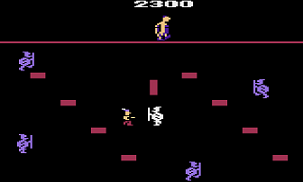
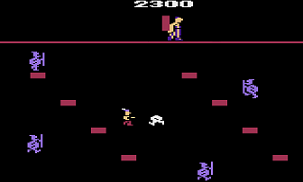
It's pretty satisfying, especially given that Caesar's jerks sure are eager to kill you (as Asterix). If you let a stunned Roman live long enough to come to his senses -- a siren will ring a brief warning just before this occurs -- he'll speed up a bit and turn red, lethal to the touch, impervious to big rocks and suddenly concerned with getting in your way from above or below by reversing direction whenever necessary.
He'll evade you when you're imbued with Potion Power (see below). At least he calms down and turns blue again if he's killed you, so it's easy to get even.
Upon hearing a jaunty lil' number, you'll notice that the Druid (cleverly named Getafix, at least in the comic's English translation) has replaced Obélix, walking more slowly. If a rock is falling, it will magically vanish. At a random time before or when the music ends, he'll drop a Magical Potion.
If you catch it before it falls past the playfield, you'll become swift, invulnerable and deadly to all adversaries for eight seconds. Rock-dropping is paused, but now you're able to re-blue any soldiers -- for an extra 200 points apiece -- who you've permitted to turn red.
You've done this by missing the stunned ones with your rock drops, hence giving them time to come to, or perhaps failing to time a stunning touch sufficiently to give the always sluggish Obélix a chance to reach the spot directly above. Frozen bad guys will reanimate and redden more and more quickly as the game goes on. Before long, waiting for your bulky buddy to finally line up lets your intended victim rouse himself before you've even had a shot.
Your timing with touches therefore becomes just as important as being a dead-eye with the rocks. Obélix never deviates from his route back and forth along the top, only turning around when he's made it to one border or the other; so it's best to stun a soldier only when your partner-in-squishing is nearing the proper position.
Considering this along with your inability to move vertically at will and the need to navigate around any red enemies (not to mention the blue ones you don't want to stun yet), the balance between the game's elements is clever as hell.
Admittedly, when Getafix is present, it can be frustrating to wait for the arbitrary moment when he lets the Potion plunge, especially while you're trying to dodge a bunch of reds as the happy music is obliviously playing away. "Tell that damn Ancient Minstrel to pick up the tempo, will ya?"
It's wise to stay aligned with Getafix as he ambles above, ensuring that you don't miss the dot-shaped bottle when it finally falls. You might find yourself making this harder than necessary by avoiding even the blue Romans, unwilling to freeze any and risk their subsequent deadliness. Don't sweat it, though. As long as you're not there when blue becomes red, you can just wipe 'em out when you're empotioned.
The enemies attack in four long rounds. At the end of each, the splattered soldiers stop getting replaced, leaving their rows empty once you've crushed them. Their amount in each round is random, within certain parameters:
In Round 1, I've killed between ninety-four and one hundred and ten. In 2, they can number anywhere from sixty-nine to eighty-five, whereas 3 contains around eighty. I smushed over three hundred in 4 before realizing that they're indefinite.
The Romans' initial minimum and maximum speeds are increased a bit when a new round begins. Also slightly faster are Asterix, Obélix, Getafix and, curiously, the falling rocks. Even gravity can't be trusted here in Ancient France! No wonder they need Druids. The footbridges are rearranged, making strategic planning trickier and keeping the game constantly fresh.
Romans materialize precisely where their compatriots have perished, with the potential to walk faster. This is how their speeds gradually increase throughout each round; a soldier will never change his pace, but the one who supplants him might be quicker.
Here's how it works: The more bottles Getafix has let go, the faster the bad guys can go. In Round 1, for instance, they tend to hit maximum after four Potions, but sometimes it's five.
Just to keep from being predictable, some soldiers will arrive walking slower than their fallen friends. They don't all walk completely across the playfield and back like Obélix does; the occasional blue one will turn around at a particular spot and, when he reaches it again from the other direction, sometimes continue to make that his threshold.
They don't necessarily do this to avoid you, as the reds do when you're Potioned up. Sometimes, they'll reverse and walk toward you, possibly forcing you into stunning them at inopportune times.
The manual explains that you're facing two types of adversary: "fat Legionnaires and small Centurions." The latter don't slowly replace the former until a certain amount of Potions has been dropped and the effects of the last have worn off.
In Round 1, the number is seven. As with the enemy counts, the rest are random: In Round 2, it's four or five. It's two or three in 3, and only one or two in the final, endless round.
The faster a soldier travels before you freeze him, the more he's worth as an Ancient Roman Pancake. The Legionnaires fetch from 10 to 1,000 points, whereas the thinner, slighty harder-to-hit Centurions have twice as many points on their heads.
The row occupied by a squishee has no bearing on his value. "Why, then," you ask, "shall I not remain within the two upper rows, wherein 'tis a simpler task to vanquish mine enemies?" Because you're more assured of catching the unpredictably dropped Potions when you're lower on the screen, you goofy-talking dope.
Keep in mind that Getafix and his soundtrack only enter when Obélix has reached the left-hand boundary. It first happens when he's thrice crossed to the right and back. Forever afterward, it's between twice and fource. (I say it's a word.)
When Asterix catches the Potion, he evidently drops it after taking a quick drink, as it keeps falling. If you look for his red-flashing face, you won't be confused into thinking he's missed it.
Take care with those menhirs, as they'll squash Asterix as well. He can be killed three times before the Druid presumably gets sick of resurrecting him, but additional lives are awarded at 10,000, 50,000 and 100,000 points. That's it. This arcade-based formula never fits well into a home-exclusive game, in which the extras should be ongoing.
In case I haven't made this obvious, a menhir will pass harmlessly in front of an enemy (from your perspective) unless he's stunned. If you manage to align more than one stunnee, they can all be crushed with a single rock, even though this sadly won't affect the scoring. You'll be unharmed if you're directly beneath, as each rock is pulverized upon smushing its lowest target.
A nifty touch is that the soldiers' point values, which quickly appear to replace their carcasses, take the forms of Roman numerals. If you remain on anyone's death site, you'll obviously stun the new guy at the instant he shows up.
There's an interesting programming oversight, assuming it's not a deliberately implemented strategic aid. Asterix sets out from the lower left corner of the playfield when a game begins just after the console is switched on, but starts on his most recently occupied row in each game that follows, albeit still to the extreme left.
It's exciting to continue discovering enjoyable and inventive Atari 2600 VCS games after more than forty years of using the system. This unique, consistently compelling gem certainly doesn't deserve to be overlooked. Give it some time, and you might wind up counting it among your favorites.
("Empotioned"?)
